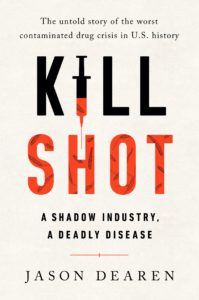Bloodthirsty—that’s how Dr. Ben Park described the fungus. Once injected into some patients’ spines, Exserohilum rostratum wormed through the cerebrospinal fluid up to the head. In the brain, it ate its way through the blood vessels and grew, choking its host’s arteries. Now that it had a name, the CDC scoured the medical literature for any information, but unearthed very little.
 The first mention of the microbe that would be named Exserohilum rostratum is found in a century-old agricultural journal article written by a Harvard-trained plant pathologist, Charles Drechsler, who noticed the microorganism as a brown splotch afflicting a flowering weed called stink grass. The fungus under Drechsler’s microscope had not been previously described. To the naked eye it was unremarkable. But when magnified, it was monstrous, having translucent, almost caterpillar-like conidia, or spores, separated into chambers, with scars at the tips. Its branching filaments, or hyphae, looked like a clutch of branches that splayed out from the surface of any plant it infected.
The first mention of the microbe that would be named Exserohilum rostratum is found in a century-old agricultural journal article written by a Harvard-trained plant pathologist, Charles Drechsler, who noticed the microorganism as a brown splotch afflicting a flowering weed called stink grass. The fungus under Drechsler’s microscope had not been previously described. To the naked eye it was unremarkable. But when magnified, it was monstrous, having translucent, almost caterpillar-like conidia, or spores, separated into chambers, with scars at the tips. Its branching filaments, or hyphae, looked like a clutch of branches that splayed out from the surface of any plant it infected.
In 1921, as Drechsler concentrated his lens on this gangly fungus, the scientific world was still coming to terms with what decades later would be recognized as a unique classification of life: the kingdom Fungi. It is still the least understood of the microbial kingdoms. Of an estimated 1.5-to-5.1 million species of fungi believed to exist on earth—which include mushrooms, the yeasts that make wine and beer, rusts, smuts, mildews, and molds—humans have named or described only about 140,000. Of those, about 300 are known human pathogens.
In the nineteenth and early twentieth centuries, bacteria and viruses were discovered as the source of major diseases like tuberculosis, cholera, and influenza, so early research focused almost entirely on those microbes. Fungi were generally categorized as members of the plant kingdom. But due to the work of Agostino Bassi, an Italian farmer obsessed with silkworms, scientists like Drechsler knew that parasitic fungi could sicken other organisms. In 1807, when his eyesight had failed him, Bassi left his job as a lawyer and returned to Lodi, the farming village where he’d grown up. Trained in science as well as law, Bassi now wrote a series of books and articles on an array of topics, from shepherding to cultivating potatoes to making cheese to producing wine.
Bassi was obsessed with one puzzle, however, that would consume him for decades. The country’s silkworms were dying from a disease called calcinaccio, or muscardine. The cause was unknown, and Bassi would launch a nearly twenty-five-year study to figure it out.
His persistence paid off. In the second decade of investigation, he noted a white efflorescence had attached itself to the sick worms. Bassi turned his focus to this intruder, which he would identify as a fungus. He found that the fungus was spreading on dead worms, and when he transferred it to the healthy silkworms, they would fall terminally ill. The fungus was a pathogen, and contagious—a heretical conclusion at a time when doctors and scientists believed the miasma theory of disease, the idea that noxious vapors caused illness.
Once injected into some patients’ spines, Exserohilum rostratum wormed through the cerebrospinal fluid up to the head.Bassi announced his findings in 1834 at the University of Pavia in front of a crowd of silkworm cultivators. To battle the contamination, he stressed the importance of sterilization, worker hygiene, and minimum exposure to germs. (In the 1860s the French microbiologist Louis Pasteur would cite Bassi in his monumental work on germ theory, as he and German scientist Robert Koch normalized the idea that microorganisms called pathogens caused many human diseases.)
At the turn of the twentieth century, most doctors did not regularly consider fungi when treating sick patients. This started to change in the United States in the 1890s, when Dr. Caspar Gilchrist, who would join the Johns Hopkins bacteriological re-search laboratory, examined two men from California’s Central Valley who died from what appeared to be tuberculosis, a bacterial disease. Both men, Portuguese immigrants who’d worked on farms, had been in agony from an infection that caused “horribly destructive” lesions throughout their body and organs. But tests for the bacterium that caused tuberculosis were negative. Instead, Gilchrist would identify the fungus Coccidioides as the cause—the first diagnosed cases of Valley fever, a potentially deadly fungal disease that continues to afflict farmworkers and residents of certain areas of California and the Southwestern U.S. to this day.
The field of medical mycology, the study of fungal diseases in humans, grew in popularity as fungal pathogens were implicated in other perplexing cases, and doctors were trained for the first time to consider fungi along with bacteria and viruses in their differential diagnoses. The first cases of fungal meningitis in the United States were reported in New York in 1916, and Columbia University College of Physicians and Surgeons would launch the first full-time medical mycology laboratory in the nation a decade later, in 1926. A dogged research scientist named Rhoda Benham oversaw its creation just as women were for the first time being allowed to earn doctorates at Columbia. Her lab would train a generation of scientists, including Elizabeth Hazen, who developed nystatin, the first effective antifungal drug.
Still, in the 1920s most research into fungal disease revolved around crops. It was in this scientific milieu that Drechsler de- scribed what would later be named Exserohilum rostratum when, a few years into his job with the Department of Agriculture, he was asked to investigate a major problem afflicting cereal crops. Plant diseases with monstrous names like spot blotch, foot rot, eyespot, net blotch, and stripe were devastating commercial cereal crops like rice and barley around the globe. Each night after dinner with his family, Drechsler settled in at his desk to draw handsome skilled renderings of dozens of fungal species. His microscope was outfitted with a camera lucida, a contraption with a lens and a mirror held in place by a metal rod. The lucida, when looked through just right, projected the image under his microscope onto a piece of drawing paper. He would trace the outlines of the microbe he saw there, then use a pen and India ink to draw it, dot by dot, in the pointillist style that he’d learned at Harvard. His wife often had to coax him away from his desk at one or two in the morning.
Dreschler focused in particular on E. rostratum’s conidia, drawing the chambered reproductive spores at the top of the page, each with its distinct scar. On the right side of his sheet he sketched an overhead view of a conidium that demonstrated the spindly leglike hyphae radiating from it. The scars developed in the spot where the spore disconnected from the hypha, launching out into the world to reproduce.
At the time, even fewer of the world’s fungi were known, and each specimen was a revelation. The samples of stink grass alone would yield twelve novel species. (A decade later, some fungi in this group would be reclassified under a new genus, named in his honor: Drechslera). There was one he believed to be of the genus Helminthosporium, a collection of dematiaceous, or darkly pigmented, fungi. It needed a name that described the elongated, caterpillar-like spores. He settled on the word rostrate, a zoological term meaning beak-like. Helminthosporium rostratum.
In the 1940s, fungal diseases were ravaging soldiers fighting in the theaters of Europe, driving Elizabeth Hazen and Rachel Fuller’s research into the development of nystatin, the first official antifungal medication. In 1955, amphotericin B was extracted from a bacterium found in the banks of the Orinoco River in Venezuela. For decades those two drugs were our best weapons against a broad spectrum of fungi, but amphotericin B could also cause organ failure or other fatal complications in patients as well as cure them. It wasn’t until AIDS began to decimate a generation in the eighties and nineties that a third option emerged. Voriconazole was patented in 1990, but as the AIDS emergency faded in the United States, so, too, did antifungal drug development.
Nearly a century after Dreschler first named E. rostratum, doctors still had precious few options to defeat it.
*
Exserohilum rostratum has a spotty biography. After Drechsler named his gnarled, scarred fungus, it largely disappeared from published works until the 1970s, when USDA pathologist named Kurt Leonard, and Edna Suggs, a plant pathologist at North Carolina State University, saw it on some corn leaves. The microbe was somewhat unusual in that it did not attack its host indiscriminately, but moved in only under the right conditions, feeding on dead leaf tissue already damaged by insects.
There was something else about the fungus that surprised Leonard and Suggs: it was a supercharged reproducer. In two days in the lab, one spore had covered a leaf with a carpet of fungal growth. Compared to its biological relatives, it was moving at light speed. Not only that, its spores were able to launch into the air using an electromagnetic mechanism that he had only ever seen in fungi classified as ascomycetes.
But the scars were its hallmark. Leonard and Suggs wanted a word that captured this trait, and fused the Latin exsertus, which means “to thrust out,” and hilum, the term for a scar left on a seed, to form Exserohilum. For varietals with the beak-like stretched-out spores, or conidia, they’d keep Drechsler’s description, rostratum.
Exserohilum rostratum.
Nearly four decades later, sitting at her microscope in a dimly lit lab in Virginia, Beverly Jones and her colleagues would recognize it in the spinal fluid of a patient who had died from fungal meningitis. While she had been able to track down a decent amount of information about E. rostratum’s pathogenic relationship with plants, it appeared that no one had ever studied its ability to adapt to a human’s central nervous system.
The CDC needed to learn more about how the fungus survived an immune response and launched a battery of experiments to learn how E. rostratum killed.
*
The temperature of a healthy human body is 37 degrees Celsius (98.6 degrees Fahrenheit). This warmth serves an important immune function, neutralizing many intruders before they get comfortable. About 300 fungal pathogens, like the one behind the white-nose syndrome wiping out the world’s population of bats, can grow at 37 degrees and cause disease in humans and other mammals.
The move toward drug delivery by injection also opened a new pathway into the human body…For an opportunist like E. rostratum, this innovation was its Trojan horse.For Exserohilum rostratum to gain purchase in a human host, it needed a lot of help. The fungus is commonly found in grasses and soil, and it thrives in humid climates, including in NECC’s home state of Massachusetts. Healthy people inhale it regularly with few problems—human skin and cilia are our first-line defenses. If the contaminated steroids had been administered orally, the only real drug delivery method until the mid-1920s, the fungus likely would have perished in stomach acid. The move toward drug delivery by injection also opened a new pathway into the human body. The invention of disposable, preloaded plastic syringes in 1955 increased the speed and ubiquity of the method—no more cleaning and reloading needles, as in the old days. In 1926, the USP for the first time listed only two injections. By 2013, the USP listed 566 different types of approved drug injections. For an opportunist like E. rostratum, this innovation was its Trojan horse.
It also needed food and a suitable environment in which to germinate. And it had competition. Scientists at the FDA and CDC found bacteria and other species of fungi, including molds from the genera Cladosporium and Aspergillus, in NECC’s drugs. But at 37 degrees Celsius in a CDC lab, E. rostratum outcompeted the others.
Next, E. rostratum, which had been previously known to eat dead plant tissue, developed a taste for blood. Doctors at CDC guessed that it was drawn in by the iron, which is also found in the leaves of plants.
E. rostratum also had help fighting the immune systems of its hosts—the steroid itself. Inflammation—the cause of the back pain in most of the outbreak patients—is a normal immune response, an alarm that sounds in the presence of a pathogen or injury. When a pathogen invades, the immune system calls in its soldiers, white blood cells like T cells, B cells, monocytes, and granulocytes like neutrophils. Steroids suppress this immune response, reducing in- flammation and its accompanying pain, and buying E. rostratum time to grow and multiply.
rostratum had another advantage: pigmentation. Dematiaceous molds, so-called because of the brown and black melanin in their cell walls, are able to gird themselves against another human defense. When a pathogen invades, the immune system triggers bursts of oxygen and nitrogen to neutralize it, but some pigmented fungal pathogens react to oxidative burst attack by adapting their DNA. Instead of dying, the molds learn to withstand it.
With such good fortune, E. rostratum thrived. So why would it kill such an amenable host?
There is a stark difference between fungi and other pathogens, like bacteria. In his book about the cholera epidemic in nineteenth-century London, The Ghost Map, Steven Johnson explains: “A lethal strain can make untold billions of copies of itself in a matter of hours, but that reproductive success usually kills off the human body that made that reproduction possible. If those billion copies don’t find their way into another intestinal tract quickly, the whole process is for naught.” A bacterial pathogen like Vibrio cholerae sometimes will slow its reproduction down to keep its host alive. But fungi don’t need a live host to survive. In fact, most feed on dead tissue.
“When [fungal pathogens] get into an ecosystem—a vertebrate host, for example—they simply don’t care. They have no need for that host in order to go forward. They will take down every last member of the species,” as molecular microbiologist and immunologist Dr. Arturo Casadevall said in Fungal Diseases: An Emerging Threat to Human, Animal, and Plant Health, a workshop and report funded by the National Institutes of Health in 2011. For invading fungi, the host’s death is part of the equation.
E. rostratum had existed for millions of years on this planet, biding its time, patiently eating grasses and corn, until a better opportunity presented itself.




















